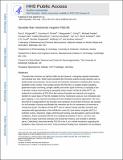| dc.contributor.author | Fitzgerald, P J | |
| dc.contributor.author | Pinard, C R | |
| dc.contributor.author | Camp, M C | |
| dc.contributor.author | Feyder, M | |
| dc.contributor.author | Sah, A | |
| dc.contributor.author | Bergstrom, H C | |
| dc.contributor.author | Graybeal, C | |
| dc.contributor.author | Schlüter, O M | |
| dc.contributor.author | Grant, S G | |
| dc.contributor.author | Singewald, N | |
| dc.contributor.author | Holmes, A | |
| dc.contributor.author | Liu, Yan | |
| dc.contributor.author | Xu, Weifeng | |
| dc.date.accessioned | 2017-09-21T19:55:03Z | |
| dc.date.available | 2017-09-21T19:55:03Z | |
| dc.date.issued | 2014-12 | |
| dc.date.submitted | 2014-07 | |
| dc.identifier.issn | 1359-4184 | |
| dc.identifier.issn | 1476-5578 | |
| dc.identifier.uri | http://hdl.handle.net/1721.1/111618 | |
| dc.description.abstract | Traumatic fear memories are highly durable but also dynamic, undergoing repeated reactivation and rehearsal over time. Although overly persistent fear memories underlie anxiety disorders, such as posttraumatic stress disorder, the key neural and molecular mechanisms underlying fear memory durability remain unclear. Postsynaptic density 95 (PSD-95) is a synaptic protein regulating glutamate receptor anchoring, synaptic stability and certain types of memory. Using a loss-of-function mutant mouse lacking the guanylate kinase domain of PSD-95 (PSD-95GK), we analyzed the contribution of PSD-95 to fear memory formation and retrieval, and sought to identify the neural basis of PSD-95-mediated memory maintenance using ex vivo immediate-early gene mapping, in vivo neuronal recordings and viral-mediated knockdown (KD) approaches. We show that PSD-95 is dispensable for the formation and expression of recent fear memories, but essential for the formation of precise and flexible fear memories and for the maintenance of memories at remote time points. The failure of PSD-95GK mice to retrieve remote cued fear memory was associated with hypoactivation of the infralimbic (IL) cortex (but not the anterior cingulate cortex (ACC) or prelimbic cortex), reduced IL single-unit firing and bursting, and attenuated IL gamma and theta oscillations. Adeno-associated virus-mediated PSD-95 KD in the IL, but not the ACC, was sufficient to impair recent fear extinction and remote fear memory, and remodel IL dendritic spines. Collectively, these data identify PSD-95 in the IL as a critical mechanism supporting the durability of fear memories over time. These preclinical findings have implications for developing novel approaches to treating trauma-based anxiety disorders that target the weakening of overly persistent fear memories. | en_US |
| dc.description.sponsorship | National Institutes of Health (U.S.) (Grant MH080310) | en_US |
| dc.language.iso | en_US | |
| dc.publisher | Nature Publishing Group | en_US |
| dc.relation.isversionof | http://dx.doi.org/10.1038/mp.2014.161 | en_US |
| dc.rights | Article is made available in accordance with the publisher's policy and may be subject to US copyright law. Please refer to the publisher's site for terms of use. | en_US |
| dc.source | PMC | en_US |
| dc.title | Durable fear memories require PSD-95 | en_US |
| dc.type | Article | en_US |
| dc.identifier.citation | Fitzgerald, P J et al. “Durable Fear Memories Require PSD-95.” Mol Psychiatry 20, 7 (December 2014): 901–912 © 2015 Macmillan Publishers Limited | en_US |
| dc.contributor.department | Massachusetts Institute of Technology. Department of Brain and Cognitive Sciences | en_US |
| dc.contributor.department | Picower Institute for Learning and Memory | en_US |
| dc.contributor.mitauthor | Liu, Yan | |
| dc.contributor.mitauthor | Xu, Weifeng | |
| dc.relation.journal | Molecular Psychiatry | en_US |
| dc.eprint.version | Author's final manuscript | en_US |
| dc.type.uri | http://purl.org/eprint/type/JournalArticle | en_US |
| eprint.status | http://purl.org/eprint/status/PeerReviewed | en_US |
| dspace.orderedauthors | Fitzgerald, P J; Pinard, C R; Camp, M C; Feyder, M; Sah, A; Bergstrom, H C; Graybeal, C; Liu, Y; Schlüter, O M; Grant, S G; Singewald, N; Xu, W; Holmes, A | en_US |
| dspace.embargo.terms | N | en_US |
| dc.identifier.orcid | https://orcid.org/0000-0003-0096-2288 | |
| mit.license | PUBLISHER_POLICY | en_US |
| mit.metadata.status | Complete | |
